All screenshots and the featured image were taken by me.
Contains some spoilers for Persona 4, Fire Emblem: Three Houses (including DLC), Undertale and a link to potential spoilers for The Last of Us Part 2.
Representation in video games and LGBT+ representation in particular is a mixed bag. It’s one of those things that is at once easy to do and also extremely difficult to get right, without coming off as lazy, or inaccurate, or even downright offensive sometimes. I’ve seen a massive range in the games I’ve played recently, from well-rounded characters, to attempts at representation that miss the mark in some ways, to offensive stereotypes.
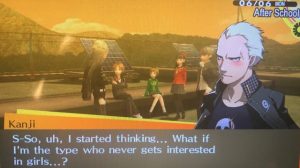
Kanji from ‘Persona 4’ speaking to the Investigation Team
Fire Emblem: Three Houses is an interesting one to start with because it does far more than the previous games in the series (except perhaps Shadows of Valentia, where Leon is canonically gay), and at the same time isn’t really a step forward at all. The more recent games in the series allow you to pair up units romantically, including the player character unit, for various benefits. The previous game, Fire Emblem Fates, has two units that can potentially be romanced by Corrin (the player unit) regardless of whether you chose Male Corrin or Female Corrin – Niles, and Rhajat. However, it’s a Pokemon-type situation: you only have Niles as a unit in one version of the game and Rhajat in the other version, because in Conquest you’ve sided with one kingdom, and in Birthright you sided with the opposing kingdom, changing the cast entirely. Furthermore, although Fates’ cast has a lot of variety, neither Niles nor Rhajat are particularly nice, which is a problem in itself: Niles is just unpleasant overall, and Rhajat is really obsessive and essentially stalks Corrin. And on top of that, you may not encounter Rhajat at all, and therefore fail to recruit her entirely. All this adds up to representation that just raises more questions.
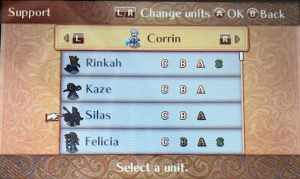
The Support system in ‘Fire Emblem Fates’
Three Houses does a better job but also doesn’t quite get there. This game also features units that can be romanced (post time-skip) regardless of whether you chose Male Byleth or Female Byleth: Gilbert, Alois, Yuri, Jeritza, and Linhardt – and Sothis, Rhea, Mercedes, Dorothea, and Edelgard.
However, while all of Female Byleth’s options are at least to some extent outright romantic, for Male Byleth this is the case only for Linhardt (Gilbert and Alois are platonic). If you have the paid DLC, Yuri and Jeritza also count, but in the base game you have just one option. This seems like a baffling choice, especially given how many choices Female Byleth has. If they had equal options I’d be inclined to say this wasn’t bad at all, but as it stands, Three Houses could be better.
The Persona series is also worth considering, as a series I enjoy very much. Persona 2 does allow the protagonist, Tatsuya, to express feelings for his (male) childhood friend Jun, but I haven’t got round to playing this yet. Persona 4, meanwhile, has Shadow Kanji, a character I’ve discussed in a previous article.
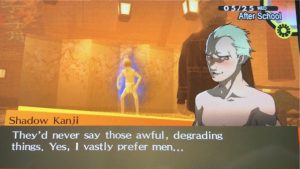
Kanji’s Shadow Self, the side he represses because he doesn’t accept it as part of who he is, is born from his doubts over his attraction to the male detective Naoto, as well as the ridicule he experiences due to enjoying stereotypically feminine hobbies such as sewing. Persona 4 does a great job looking at identity (not just for Kanji, but for other characters too) and also how other people (like Yosuke) can react.
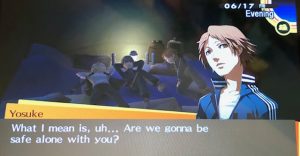
But Kanji’s actual Social Link, which you can complete after his role in the plot is resolved and his Shadow is defeated, focuses more on self-acceptance in general. Although there are further allusions to his doubts about his sexuality, nothing is made clear and you certainly don’t have the option to romance Kanji like you can choose to romance the girls in your party. So Persona 4 can be described more as a step in the right direction, and certainly very interesting, but again doesn’t go far enough.
Persona 5, unfortunately, completely regresses with the appearance of two stereotypically gay men at two points in the game, who are extremely flamboyant and who flirt with your friend Ryuji, who is 16 or 17 at the time.
Yeah.
The rest of the game doesn’t go into any of the themes hinted at with Kanji in the previous game, which makes this whole situation even more disappointing. Although the scene was revised in the expanded re-release, Persona 5 Royal, I think it should have just been cut entirely. It’s good that ATLUS listened to criticism, but it’s also not good that they took such a backwards step from Persona 4.
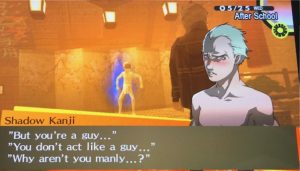
I’ve only discussed two game series that I have played and enjoyed, but there are other games – big games – that have varying levels of representation. Take The Last of Us Part 2, a game that released very recently: Ellie, the main character, is gay, and this has unfortunately caused problems for some people. This game has been criticised for myriad other reasons, some of which I do agree with from what I’ve seen, but the main character’s sexuality really shouldn’t come into it at all.
Now I want to talk about two games I love that have done representation right. In Stardew Valley the Farmer can marry absolutely anyone who isn’t already married, or indeed far older than yourself. It doesn’t make a big deal about it, it’s just there, and what’s really nice is that all the features of the marriage remain intact regardless – for example, you can still have children, but the dialogue is changed to say they are adopted instead. The lack of limitations and the range of options you have is excellent.
Undertale perhaps goes one step further, with several instances of (actually canonical) representation. The scientist Alphys’s crush on, and later relationship with, the warrior fish-woman Undyne is not marked out as different in any way just because it is between two women: one of the funniest moments in the whole Mettaton saga is in an optional dialogue choice during his quiz where he completely calls Alphys out on her habit of naming programming variables after Undyne. Furthermore, you can help matchmake the two male guards known as RG 01 and RG 02, and Frisk, the main character, is non-binary.
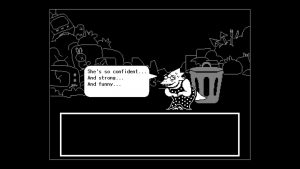
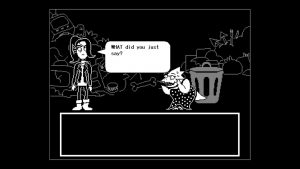
Poor Alphys
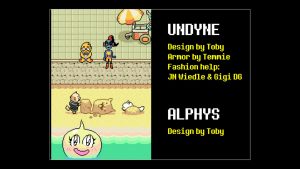
From the credits
Both Night in the Woods and Celeste were included in itch.io’s incredible and massive Bundle For Racial Justice and Equality, available earlier this month. I haven’t started either of them but they both feature LGBT+ characters that are not just incidentally so, but it’s part of their established character.
And that, I think, is what people want to see. Although being offered limited options, for example what we see in the Fire Emblem series, is sometimes good enough, it often falls short and sometimes even feels forced and unnatural: and regardless it’s completely optional. Stardew Valley arguably handles this far better, because there’s no such limitations. Characters, main characters, that are clearly LGBT+ are in short supply (and trans characters in particular rarely appear at all), but it would be great to see more of them, so games can start to reflect their audience in a more effective way.
